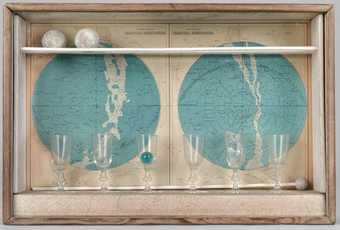The Joseph Cornell exhibition at the Whitechapel Gallery in 1981 was a milestone for me as an artist. I had seen his art in books before, but this had not prepared me for the total absorption I felt that his works created. I had only once or twice before encountered this feeling of being transported before an image – a loss of orientation in time and space. Every piece seemed to induce a gentle delirium.
In his essay The Essential Solitude from 1955, the French writer and philosopher Maurice Blanchot refers to the ‘absence of time’ when one experiences such fascination, and it was as if, through Cornell, I was being drawn into – and sharing – the artist’s vision. The show puzzled me. How could ordinary found images have such a power? I went back again and again, though each visit only deepened the mystery.
Cornell helped me to accept what I already somehow knew: that I could be fascinated only by preexisting images – something that was already out there in the world rather than of my making. As I learned more about his life I realised that the power of his work came from his immersion in his collection of objects. In the same essay, Blanchot describes the artist as an ‘exile from life in the illusory world of images’, a description which perfectly describes Cornell. Despite a busy teaching career, I have always held this separation from life as an ideal no matter how much I have been forced by circumstance to fall short of it.
Tate’s work by Cornell, Planet Set, Tête Etoilée, Giuditta Pasta (dédicace) from 1950, belongs to the period just after the war when Cornell’s boxes became sparser and emptier. The paper birds had flown. Still based on the penny arcade machines that he salvaged from the amusement parks of pre-war New York, Planet Set continues to refer to the ‘forgotten games’ that were once played with the mechanisms of the perpetually moving balls. However, for all the references to movement, celestial and mechanical, the atmosphere is of atrophy, stillness and neglect.
Following the sense of violence suggested in his boxes made during the Second World War with their smashed glass and splattered paint, the 1950s and 1960s works such as Planet Set and Toward the Blue Peninsula (for Emily Dickinson) c1953 are finally emptied of imaginary inhabitants, and as life ebbs away, so these miniature spaces paradoxically achieve an intensity of imaginary occupation. The less that they are apertures on to another world, the more they become impenetrable material barriers.
Cornell’s relationship with his found images is the opposite of the mastery implied in the word ‘appropriation’, and this, I feel, separates him from the surrealists and the work of his friend Duchamp. His images have a previous life in circulation where, in their legibility, they have been universally overlooked, treated with indifference and eventually cast out. Like orphans, Cornell gives them new homes in his boxes. In these final resting places, they take on a second life, a visibility within the dark aura of fascination. Where once they were invisible in the transparent interface of everyday consumption, through obsolescence, death and the resurrective process of Cornell’s art, they somehow finally show themselves. He is attached to the material leftovers of communication, to the residues of images when their instrumental or semantic ties to the world have been severed by time and abandoned. As the image is drained of its communicative life, it seems to achieve a spiritual afterlife.

